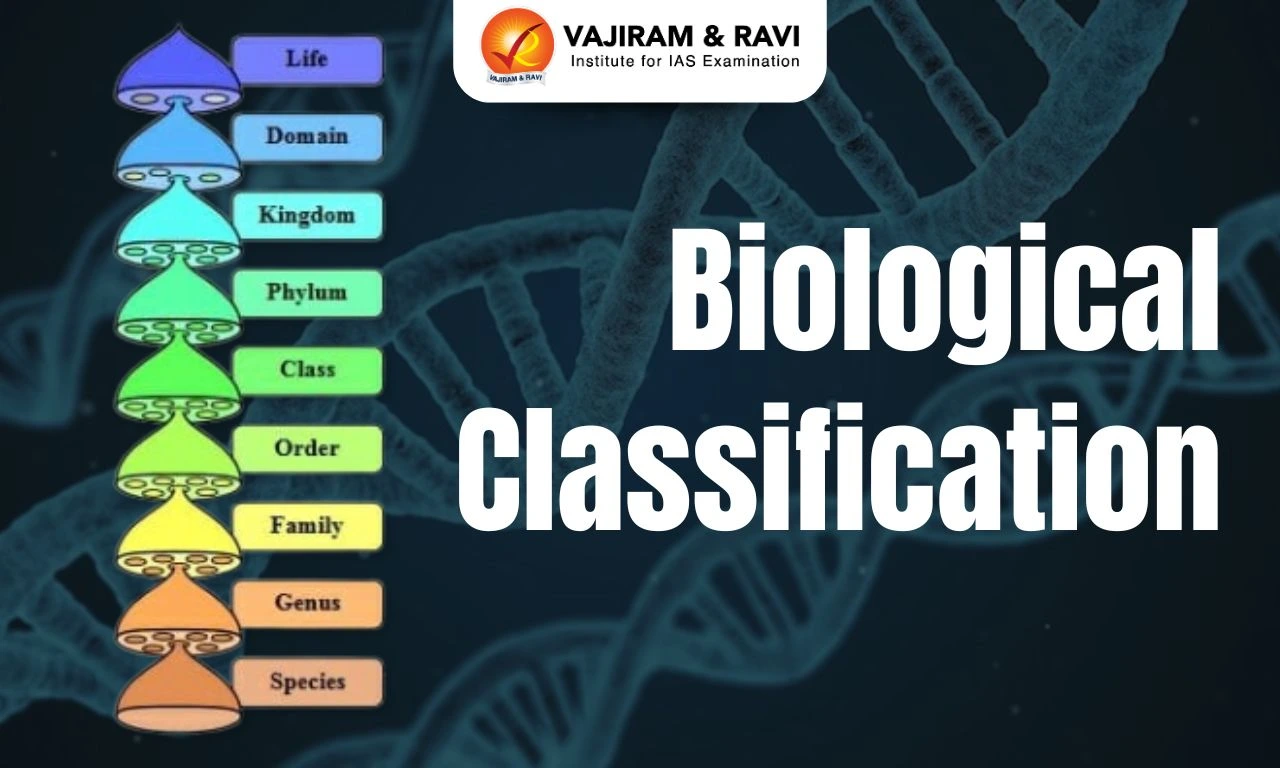Biological classification is the process of organising living organisms into logical hierarchical groups based on their similarities and differences. The main purpose of classification is to simplify the study of vast biodiversity. Over the years, taxonomists have developed a system consisting of domains, kingdoms, phyla, classes, orders, families, genera and species to classify all life forms.
R.H. Whittaker (1969) proposed a five Kingdom Classification. These are Monera, Protista, Fungi, Plantae and Animalia.
Taxonomic Hierarchy
Taxonomy is a branch of science that deals primarily with the description, identification, nomenclature, and classification of organisms. It is essential to classify living organisms into different groups and subgroups.
- Taxonomy hierarchy: The process of placing or grouping organisms in different taxonomic groups is known as the taxonomy hierarchy.
- Domain: It is the highest level of classification that constitutes three domains of life such as Archaea, Bacteria, and Eukarya.
- Kingdom: Each domain is further divided into kingdoms.
- For example, Eukarya has five kingdoms: Animalia, Plantae, Fungi, Protista, and Monera.
- Phylum: Within each kingdom, organisms are grouped into phyla based on shared structural body plans and other defining characteristics.
- For example, Chordata is one of the phyla of the Animalia kingdom.
- Class: Phyla are divided into classes, which further specify characteristics shared by groups of organisms.
- For example, Mammalia is a class within Chordata.
- Order: Classes are divided into orders, representing specific arrangements of families.
- For example, Carnivora is an order of Mammalia.
- Family: Orders are divided into families, indicating related groups of genera.
- For example, Canidae is a family of Carnivora.
- Genus: Families are divided into genera, representing groups of species that are more closely related.
- For example, Vulpe is a genus under Canidae.
- Species: The species is the most specific level and refers to individual organisms that share very similar characteristics and can interbreed to produce fertile offspring.
- For example, Vulpe vulpe is a species (common name – Red fox) of the Vulpe genus.
Historic Evolution of Biological Classification Systems
Classification is the process of organizing organisms into groups based on similarities and differences between them. It allows us to better understand the diversity of life on Earth. Biological classification has evolved over centuries, from the time of Aristotle to the six-kingdom classification system used today.
| System | Key Features | Limitations |
| Two Kingdom, Proposed by Aristotle | – Binary split into Plantae (Plants) and Animalia (Animals) | – Failed to account for microscopic organisms. |
| Three Kingdom, Suggested by Ernst Haeckel | – Added Protista as the third kingdom for unicellular eukaryotes | – Could not resolve dichotomies between multicellular plants, animals and other macroscopic species. |
| Four Kingdom, proposed by Herbert Copeland | – Distinguished Fungi as separate from Plantae | – The Protista kingdom became saturated with phylogenetically unrelated species. |
| Five Kingdom, by Robert Whittaker | – Further split unicellular eukaryotes into Protista and prokaryotes into Monera | – Constraints related to integrating molecular taxonomy emerged later. |
| Six Kingdom, by Carl Woese’s three-domain model in 1990. | – Divided Monera into Bacteria and Archaea while subsuming other groups under Eukarya | – Integrating advanced phylogenetic techniques remains ongoing. |
Five Kingdom Classification
In 1969, R.H. Whittaker proposed a five-kingdom classification system for living organisms based on differences in their cell structure, body organization, mode of nutrition, reproduction and phylogenetic relationships. The five kingdoms he defined were:

Kingdom Monera
Monera includes all prokaryotic organisms like bacteria.
| Kingdom Monera – Main characteristics |
| – Lack of a true nucleus and membrane-bound cell organelles
– They have unicellular body organisation. – Cell wall made of peptidoglycan, polysaccharides and lipids – They reproduce asexually by fission, budding, fragmentation or spore formation. – They have circular DNA located directly in the cytoplasm. – They evolved around 3.5 billion years ago and were the first life forms on Earth. |
- Monerans have adapted to survive in diverse environments like soil, water, extreme temperatures, salinity and acidity.
- They exhibit a range of nutritional modes including photosynthesis, decomposition, symbiosis and parasitism.
- Bacteria in Kingdom Monera can be classified based on different criteria:
Based on the shape:
| Shape | Examples |
| Spherical (coccus) | Staphylococcus |
| Rod-shaped (bacillus ) | Lactobacillus |
| Comma-shaped (vibrio) | Vibrio cholera |
| Spiral (spirillum) | Spirochaetes |
Based on the Nutrition:
| Mode | Examples |
| Autotrophic | Nitrobacter, Sulphur bacteria |
| Saprotrophic | Clostridium |
| Symbiotic | Rhizobium |
| Parasitic | Mycoplasma |
Based on the respiration:
| Type | Examples |
| Aerobic | Pseudomonas |
| Anaerobic | Clostridium |
| Facultative anaerobic | E.coli |
Archaebacteria and Eubacteria
Monerans are further divided into:
- Archaebacteria: They differ in cell wall and lipid structure from other bacteria and can live in extreme conditions of temperature, salinity and acidity. Examples include:
- Methanogens: They produce methane gas found in the guts of ruminants like cows.
- Halophiles: They are found in very salty waters.
- Thermoacidophiles: They thrive in hot acidic environments.
- Eubacteria: All other ‘true’ bacteria. They have a thicker cell wall and include photosynthetic cyanobacteria, chemosynthetic bacteria, decomposers and disease-causing forms.
- Structure of a Bacterial Cell:

- A typical bacterial cell has the following parts:
- Cell wall: Made of peptidoglycan
- Cell membrane: phospholipid bilayer with proteins
- Cytoplasm: Contains circular DNA, ribosomes, nutrients
- Pili: For attachment
- Flagellum: For movement
- Capsule: Protective layer in some bacteria
Kingdom Protista
They include all eukaryotic unicellular organisms. Some key features are:

| Kingdom Protista | |
– They include all eukaryotic unicellular organisms. Some key features are:
|
|
Chrysophytes
 |
– These are microscopic unicellular aquatic organisms.
– They contain chlorophyll for photosynthesis. – These cell walls contain silica in diatoms giving them a shell-like covering. – They help in detecting water pollution based on species distribution. – Examples: Cymbella, Navicula, Coscinodiscus sp |
Pyrrophyta: The Dinoflagellates
 |
– They are mainly marine organisms and appear in different colours.
– They have two flagella for movement. – Some show blooms or population explosions forming red tides which can kill other marine life. – Examples: Noctiluca, Peridinium and Gonyaulax |
Euglenophyta: Euglenoids
 |
– They are freshwater organisms found in stagnant water.
– They have flagella and a protein-rich flexible pellicle. – They can be autotrophic in sunlight or heterotrophic in darkness. – Examples: Eugleana, Phacus, Astasia, Trachelomonas |
Slime Moulds
 |
– Saprophytic protists feeding on bacteria found in decaying material.
-They can form aggregates called plasmodium containing the large multi-nucleate mass of protoplasm. – They can survive extreme environmental conditions. – There are two groups of slime moulds-
|
Protozoans
 |
– Microscopic heterotrophic protists acting as predators or parasites
– Classified based on locomotory organs as:
– They act as disease vectors and human parasites. |
Examples of common protozoans:
| Type | Examples | Characteristics |
| Amoeboid | Entamoeba histolytica | – It causes amoebiasis dysentery |
| Flagellated | Trypanosoma | – It causes sleeping sickness |
| Ciliated | Paramoecium | – Model lab organism with food vacuoles |
Kingdom Fungi
Fungi comprise eukaryotic, saprophytic organisms which may be unicellular or multicellular. Key features include:
- Cell walls are made of chitin and polysaccharides.
- Body organised as slender filaments called hyphae.
- Networks of hyphae form thick bundles called mycelium.
- They reproduce by spores and sexually by cell fusion.
- They occur as saprophytes, decomposers or parasites.
- The phyla of Kingdom Fungi are classified based on reproductive and morphological characteristics:
| Phylum | Examples | Key Features |
Phycomycetes
 |
Mucor, Rhizopus | – Aseptate hyphae produce zoospores. |
Ascomycetes
 |
Aspergillus and yeast | – Septate hyphae produce sexual spores called ascospores. |
Basidiomycetes
 |
Agaricus, Puccinia | – Club-shaped basidia produce external basidiospores. |
Deuteromycetes
 |
Alternaria | – Only reproduces asexually through conidia. |
- Examples of important fungi:
- Penicillium is used for producing antibiotics.
- Saccharomyces species are used in the baking industry.
- Mucor and Rhizopus are used for fermentation processes.
- Agaricus and Morchella are used as food sources.
- Ustilago and Puccinia act as plant parasites.
Kingdom Plantae
These include all eukaryotic photosynthetic organisms commonly called plants. Key points about Kingdom Plantae include:
- These are eukaryotic cells with cell walls made of cellulose.
- They contain chloroplasts with chlorophyll pigment.
- They exhibit alternation of generations between diploid sporophyte and haploid gametophyte stages.
- They consist of five major divisions:
- Algae: aquatic photosynthetic organisms
- Bryophytes: small herbaceous plants
- Pteridophytes: seedless vascular plants
- Gymnosperms: produce naked seeds
- Angiosperms: flowering plants producing fruits and seeds
- Some examples of plants with unusual nutrition:
- Insectivorous plants (heterotrophic): Venus fly trap, bladderwort
- Parasitic plants (heterotrophic): Cuscuta

- The plant kingdom is classified into different divisions, classes, orders, families, genera and species based on characteristics like vascular tissue, seed formation and embryo development. A simplified framework is given below:

Kingdom Animalia
This kingdom includes all heterotrophic, multicellular eukaryotic organisms which lack cell walls. Some salient features are:
- Lack of cell walls and chloroplasts.
- They obtain nutrition by ingestion – holozoic nutrition.
- The diploid stage dominates the life cycle.
- They exhibit elaborate sensory, nervous and locomotory systems.
- Reproduction is sexual with a population of separate males and females.
- Kingdom Animalia is classified hierarchically based on morphology, anatomy and embryology into various taxa illustrated below:

Some well-known animal phyla:
| Phylum | Examples | Characteristics |
| Porifera | Sponges | Asymmetric pores throughout the body |
| Coelenterata | Jellyfish, corals | Sac-like body with a single opening |
| Platyhelminthes | Tapeworms, liver flukes | Dorsoventrally flattened body |
| Annelida | Earthworms, leeches | Metamerically segmented body |
| Mollusca | Snails, bivalves | Calcareous shell, rasping tongue |
| Arthropoda | Insects, spiders | The chitinous exoskeleton, jointed legs |
| Echinodermata | Starfish, sea urchins | Endoskeleton of calcareous plates |
| Chordata | Fish, frogs, birds | Bilateral symmetry, notochord, dorsal nerve cord |

Significance of the Five Kingdom Classification
The five-kingdom classification introduced by Whittaker has the following advantages:
- Broad framework for taxonomic studies: It divided the entire spectrum of life forms into five kingdoms providing a standard framework for biodiversity research.
- Distinguish prokaryotes from eukaryotes: The identification of Monera accommodated prokaryotes like bacteria separately from eukaryotic organisms.
- Resolved issue of unicellular eukaryotes: The Protista kingdom was created for unicellular eukaryotes, while multicellular eukaryotes were kept in separate kingdoms.
- Based on natural affinities: Related organisms were grouped based on body designs, structure, and reproductive mechanisms indicating their evolutionary relationships.
- Comprehensive coverage of biodiversity: All known life forms like archaebacteria, protists, fungi, plants and animals were covered under this five-kingdom system exhaustively.
Limitations of the Five Kingdom Classification
While the five-kingdom classification system is extensively used, it has some limitations:
- Does not reflect the latest taxonomic developments: Recent advances in cytology, genetics and molecular biology have led to modifications in classifications that are not covered here.
- Position of viruses unclear: Being non-cellular, viruses do not appropriately fit into any kingdom, necessitating separate taxonomic treatment.
- Overlap between Protista and other kingdoms: Many unicellular algae and fungi-like organisms classified under Protista have a closer affinity to Plantae and Fungi kingdoms respectively.
- Archaebacteria requires separate treatment: Though placed in Monera, Archaebacteria are now considered a separate domain – Archaea.
- Kingdom names not fully standardized: Naming conventions used for the five kingdoms are not consistent, unlike other taxonomic ranks.
Other Aspects of Biological Classification
Certain lifeforms possess unusual characteristics requiring specialised taxonomic considerations:
| Entity | Description | Classification Approach |
| Viruses | – Infective acellular particles containing genetic material (RNA or DNA) wrapped in a protein coat. | – Based on the type of genetic material, presence of envelope, morphology and host infection. |
| Viroids | – Small circular infectious RNA particles causing diseases in plants without a protein coat. | – Grouped under subviral agents along with virusoids and satellites which depend on helpers to replicate. |
| Prions | – Infectious pathogenic entities composed entirely of misfolded proteins acting as templates inducing abnormalities. | – Classified under conformational disorders causing transmissible spongiform encephalopathies. |
| Lichens | – Composite organisms formed through the symbiotic association between a fungus (mycobiont) and a photosynthetic partner (phycobiont) like algae. | – Named and grouped under fungal partners into Classes like Ascomycetes or Basidiomycetes. |
Last updated on July, 2025
→ UPSC Notification 2025 was released on 22nd January 2025.
→ UPSC Prelims Result 2025 is out now for the CSE held on 25 May 2025.
→ UPSC Prelims Question Paper 2025 and Unofficial Prelims Answer Key 2025 are available now.
→ UPSC Calendar 2026 is released on 15th May, 2025.
→ The UPSC Vacancy 2025 were released 1129, out of which 979 were for UPSC CSE and remaining 150 are for UPSC IFoS.
→ UPSC Mains 2025 will be conducted on 22nd August 2025.
→ UPSC Prelims 2026 will be conducted on 24th May, 2026 & UPSC Mains 2026 will be conducted on 21st August 2026.
→ The UPSC Selection Process is of 3 stages-Prelims, Mains and Interview.
→ UPSC Result 2024 is released with latest UPSC Marksheet 2024. Check Now!
→ UPSC Toppers List 2024 is released now. Shakti Dubey is UPSC AIR 1 2024 Topper.
→ Also check Best IAS Coaching in Delhi
















